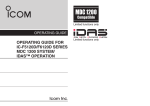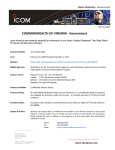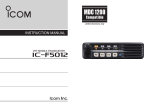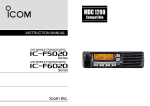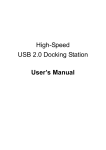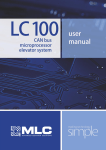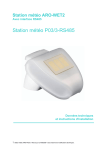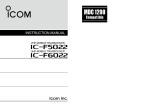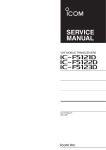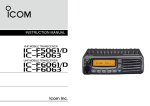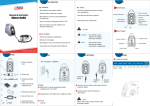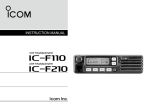Download IC-F5020_F6020 series Instruction Manual
Transcript
INSTRUCTION MANUAL VHF MOBILE TRANSCEIVERS iF5120D Series UHF MOBILE TRANSCEIVERS iF6120D Series IMPORTANT FCC INFORMATION READ ALL INSTRUCTIONS carefully and com- pletely before using the transceiver. SAVE THIS INSTRUCTION MANUAL — This instruction manual contains important operating instructions for the IC-F5121D, IC-F5123D, IC-F5128D VHF MOBILE TRANSCEIVERS and the IC-F6121D, IC-F6123D, ICF6128D UHF MOBILE TRANSCEIVERS. EXPLICIT DEFINITIONS WORD DEFINITION R WARNING! Personal injury, fire hazard or electric shock may occur. CAUTION NOTE Equipment damage may occur. If disregarded, inconvenience only. No risk of personal injury, fire or electric shock. Icom, Icom Inc. and the Icom logo are registered trademarks of Icom Incorporated (Japan) in Japan, the United States, the United Kingdom, Germany, France, Spain, Russia and/or other countries. All other products or brands are registered trademarks or trademarks of their respective holders. i • FOR CLASS B UNINTENTIONAL RADIATORS: This equipment has been tested and found to comply with the limits for a Class B digital device, pursuant to part 15 of the FCC Rules. These limits are designed to provide reasonable protection against harmful interference in a residential installation. This equipment generates, uses and can radiate radio frequency energy and, if not installed and used in accordance with the instructions, may cause harmful interference to radio communications. However, there is no guarantee that interference will not occur in a particular installation. If this equipment does cause harmful interference to radio or television reception, which can be determined by turning the equipment off and on, the user is encouraged to try to correct the interference by one or more of the following measures: • Reorient or relocate the receiving antenna. • Increase the separation between the equipment and receiver. • Connect the equipment into an outlet on a circuit different from that to which the receiver is connected. • Consult the dealer or an experienced radio/TV technician for help. CAUTION: Changes or modifications to this transceiver, not expressly approved by Icom Inc., could void your authority to operate this transceiver under FCC regulations. PRECAUTIONS R WARNING! NEVER connect the transceiver to an DO NOT use or place the transceiver in areas with tem- R WARNING! NEVER connect the transceiver to a DO NOT operate the transceiver without running the ve- R WARNING! NEVER cut the DC power cable be- DO NOT place the transceiver in excessively dusty envi- AC outlet. This may pose a fire hazard or result in an electric shock. power source of more than 16 V DC or use reverse polarity. This could cause a fire or damage the transceiver. tween the DC plug and fuse holder. If an incorrect connection is made after cutting, the transceiver might be damaged. R WARNING! NEVER place the transceiver where normal operation of the vehicle may be hindered or where it could cause bodily injury. CAUTION: NEVER allow children to touch the transceiver. CAUTION: NEVER expose the transceiver to rain, peratures below –30°C (–22°F) or above +60°C (+140°F), or in areas subject to direct sunlight, such as the dashboard. hicle’s engine. The vehicle’s battery will quickly run out when the transceiver transmits while the vehicle’s engine is OFF. ronments. DO NOT place the transceiver against walls. This will obstruct heat dissipation. DO NOT use harsh solvents such as benzine or alcohol when cleaning, as they will damage the transceiver surfaces. BE CAREFUL! The transceiver will become hot when operating continuously for long periods of time. snow or any liquids. USE the specified microphone only. Other microphones have different pin assignments and may damage the transceiver. ii TABLE OF CONTENTS IMPORTANT....................................................................................... i EXPLICIT DEFINITIONS.................................................................... i FCC INFORMATION.......................................................................... i PRECAUTIONS................................................................................. ii TABLE OF CONTENTS.................................................................... iii iii 1 PANEL DESCRIPTION................................................................1 ■ Front panel................................................................................1 ■ Function display........................................................................2 ■ Programmable function keys....................................................3 2 BASIC OPERATION....................................................................8 ■ Turning ON the power...............................................................8 ■ Channel selection.....................................................................8 ■ Call procedure..........................................................................9 ■ Receiving and transmitting.......................................................9 ■ User Set mode........................................................................12 ■ Encryption function.................................................................13 ■ Emergency transmission........................................................13 ■ Stun function...........................................................................14 ■ Priority A channel selection....................................................14 ■ Power OFF Emergency function.............................................14 3 CONNECTION AND MAINTENANCE.......................................15 ■ Rear panel connection............................................................15 ■ Supplied Accessories.............................................................16 ■ Mounting the transceiver........................................................16 ■ Antenna..................................................................................17 ■ Fuse replacement...................................................................17 ■ Cleaning.................................................................................17 ■ Options...................................................................................17 4 SAFETY TRAINING INFORMATION.........................................18 PANEL DESCRIPTION 1 ■ Front panel q Function display (p. 2) w e Speaker t r qAF VOLUME CONTROL KNOB [VOL] Rotate the knob to adjust the audio output level. tMICROPHONE CONNECTOR Connect the supplied or optional microphone. • Minimum audio level is pre-programmed. (p. 12) wUP/DOWN KEYS [CH Up]/[CH Down] Push to select an operating channel, etc. * The desired function can be assigned by your dealer. (p. 3) ePOWER KEY [ ] Push to turn the power ON or OFF. • The following optional functions are available at power ON: - Automatic scan start - Password prompt rDEALER-PROGRAMMABLE KEYS Required functions can be independently programmed by your dealer. (p. 3) N EVER connect non-specified microphones. The pin assignments may be different and may damage the transceiver. D Microphone The supplied or optional microphone has a PTT switch and a hanger hook. • The following functions are available when the microphone is ON or OFF hook (depending on the preprogramming): - Automatic scan starts when you put it ON hook. - Scan is cancelled when you take it OFF hook. - Scan is paused when you take it OFF hook. - Automatically selects the Priority channel when you take it OFF hook. - Sets to the ‘Inaudible’ mode (mute state) when you put it ON hook. - Sets to the ‘Audible’ mode (unmute state) when you take it OFF hook. 1 2 3 4 5 6 7 8 9 10 11 12 13 14 15 16 1 1 PANEL DESCRIPTION ■ Function display q w e r t y u yENCRYPTION ICON A ppears when the encryption function is activated while operating in the digital mode. i o qTRANSMIT ICON Appears while transmitting a signal. wBUSY ICON Appears while the channel is busy (receiving). eSIGNAL STRENGTH ICON Shows the relative receive signal strength level. Weak Receive Signal level Strong rLOW POWER ICON Appears when low output power is selected. tAUDIBLE ICON ➥ Appears when the channel is in the ‘Audible’ (unmute) mode. ➥ Appears when a matching signal is received. 2 uBELL ICON Appears/blinks when a matching 2/5-tone or Digital ID* is received, depending on the preprogramming. iSCAN ICON ➥ Blinks during a scan. ➥ Appears when a scan channel is selected. oALPHANUMERIC DISPLAY Displays an operating channel number, channel name, User Set mode contents, DTMF code, etc. * Digital operation only See the operating guide for details of MDC and Digital system operations. Ask your dealer for details. PANEL DESCRIPTION 1 ■ Programmable function keys The following functions can be assigned to [UP], [DOWN], [P0], [P1], [P2] and [P3] programmable function keys. Consult your Icom dealer or system operator for details concerning your transceivers programming. SCAN START/STOPKEY ➥ Push to start and cancel scanning operation. CH UP AND DOWN KEYS As described in the following topics, after pushing a programmed key, push [CH Up] or [CH Down] to select an option, setting, etc. ➥ Hold down this key for 1 second to display the scan group, then push [CH Up] or [CH Down] to select the desired one. ZONE KEY Push this key, then select the desired zone using [CH Up]/ [CH Down]. hat is “zone”?— Certain channels are grouped together W and assigned to a zone, according to their intended to use. For example, ‘Staff A’ and ‘Staff B’ are assigned to a “Business” zone, and ‘John’ and ‘Cindy’ are assigned to a “Private” zone. • When a scan is started with the Power ON Scan or Automatic scan function, push this key to cancel it. The cancelled scan resumes after the pre-programmed time period. SCAN ADD/DEL (TAG) KEY ➥Push to add the channel to, or delete it from, the current scan group. 1. P ush to display the scan group, then push [CH Up] or [CH Down] to select the desired one. 2. Push to add the channel to, or delete it from, the selected scan group. 3. Hold down for 1 second to exit the scan list selection mode. ➥While a scan is paused on a non-priority channel, push this key to delete the selected channel from the scan group. D epending on the setting, the cleared channel is added to the scan group again after the scan is cancelled. 1 2 3 4 5 6 7 8 9 10 11 12 13 14 15 16 3 1 PANEL DESCRIPTION ■ Programmable function keys (Continued) PRIO A/B KEYS ➥Push to select the Priority A or Priority B channel. ➥Hold down [Prio A (Rewrite)] or [Prio B (Rewrite)] for 1 second to rewrite the operating channel as Priority A or Priority B, MR-CH 1/2/3/4 KEYS Push to directly select memory channel 1 to 4. MONI (AUDI) KEY ➥Push to turn the CTCSS (DTCS) or 2/5-tone squelch mute ON or OFF. • Only during LMR (Land Mobile Radio) operation, push to open any squelch, or deactivate any mute functions. • Only during PMR (Private Mobile Radio) operation, push to activate one or two of the following functions on each channel (depending on the preprogramming): - Hold down to unmute the channel (‘Audible’ mode). - Push to mute the channel (‘Inaudible’ mode). - After the communication is finished, push to send a ‘reset code’ (only 5-tone operation). OTE: The ‘Audible’ (unmute) mode may automatically N return to the ‘Inaudible’ (mute) mode, after the pre-programmed time period. LIGHT KEY Push to turn ON the backlight for about 5 seconds, when the backlight function is set to “OFF” in the User Set mode. 4 LOCK KEY ➥Hold down this key until “LOCK ON” is displayed to electronically lock all programmable keys except the following: [Moni(Audi)], [Lock], [Call] (incl. Call A and Call B), [Emergency], [Surveillance], [Siren], [Lone Worker] and [Light]. ➥When the Key Lock function is ON, hold down this key until “LOCK OFF” is displayed to turn it OFF. LONE WORKER KEY Push to turn the Lone Worker function ON or OFF. • If the Lone Worker function is turned ON, and no operation occurs during the pre-programmed time period, the Emergency function is automatically turned ON. HIGH/LOW KEY Push to select the transmit output power temporarily or permanently, depending on the preprogramming. • Ask your dealer for the output power level for each selection. C.TONE CH ENT KEY Push to enter the continuous tone channel selection mode. Then, push [CH Up] or [CH Down] to change the tone frequency/code setting. The selected channel remains set as the continuous tone channel until another channel is designated as such. PANEL DESCRIPTION 1 TONE/RAN CH SELECT KEY ➥While in analog mode, push to enter the continuous tone channel selection mode. Then push [CH Up] or [CH Down] to select a desired tone frequency/code setting. After the selection, push this key again to set it. ➥While in digital mode, push to enter the RAN channel selection mode. Then push [CH Up] or [CH Down] to select a desired RAN code. After the selection, push this key again to set it. ➥While in mixed (digital and analog) mode, push to enter the continuous tone channel selection mode. Then push [CH Up] or [CH Down] to select a desired tone frequency/ code setting. After setting, push this key to set it. After that, the RAN channel selection mode appears. Select a desired RAN code with [CH Up] or [CH Down]. After the selection, push this key again to set it. WIDE/NARROW KEY Push to toggle the IF bandwidth between wide and narrow. TALK AROUND KEY Push to turn the Talk Around function ON or OFF. EMERGENCY KEY Hold down for a specified period to transmit an emergency call. • The Talk Around function equalizes the transmit frequency to the receive frequency for transceiver-to-transceiver communication. 1 • The wide passband width can be selected from 25.0 or 20.0 kHz using the CS-F3100D/F5120D cloning software. (PMR operation only) Ask your dealer for details. DTMF AUTODIAL KEY ➥Push to enter the DTMF channel selection mode, then push [CH Up] or [CH Down] to select the desired DTMF channel. ➥After selecting the DTMF channel, push again to transmit the selected DTMF code. RE-DIAL KEY Push to transmit the last-transmitted DTMF code. • TX memories are cleared after turning OFF the transceiver. • If you want to cancel the emergency call, hold down the key again, before transmitting it. 5 1 PANEL DESCRIPTION ■ Programmable function keys (Continued) CALL KEYS Push to transmit a 2/5-tone ID code. • Tone call transmission may be necessary before you call another station, depending on your signalling system. • [Call A] and/or [Call B] may be selectable when your system employs selective ‘Individual/Group’ calls. Ask your dealer which call is assigned to each key. SURVEILLANCE KEY Push to turn the surveillance function ON or OFF. When a signal is received, or a key is pushed, while this function is turned ON, the beeps do not sound and the LCD backlight does not light. SIREN Hold down for 1 second to sound the siren. This function can be used for situations other than an emergency alert, such as a security alarm for example. • The siren can only be stopped by turning OFF the transceiver power. TX CODE ENTER KEY (PMR operation only) Push to enter the TX code edit mode, then push [CH Up] or [CH Down] to set a desired digit. (p. 11) 6 TX CODE CHANNEL SELECT KEY ➥Push to enter the TX code channel selection mode, then push [CH Up] or [CH Down] to set a desired channel. (p. 10) ➥While in the TX code channel selection mode, hold down this key for 1 second to enter the TX code edit mode. Then push [CH Up] or [CH Down] to set a desired digit. (p. 11) TX CODE CHANNEL UP/DOWN KEYS Push to select a TX code channel. ID-MR SELECT KEY (PMR operation only) ➥Push to recall the received ID code. • P ush this key, then select the ID code using [CH Up]/ [CH Down]. • Up to 5 codes can be memorized. ➥Hold down this key for 1 second to clear the selected ID code. ENCRYPTION KEY While operating in the digital mode, push to turn the encryption function ON or OFF. PANEL DESCRIPTION USER SET MODE KEY ➥Hold down for 1 second to enter the User Set mode. • While in the User Set mode, push this key to select an item*, and change the value or setting using [CH Up] or [CH Down]. *Selectable items may differ, depending on the preprogramming. ➥Hold down this key for 1 second again to exit the User Set mode. The User Set mode is also available via the ‘Power ON’ function. In this case, all set mode items are available. See page 12. HOOK SCAN When the Hook Scan function is pre-programmed, push this key to temporarily disable the function. Push this key again to enable the function. 1 Ext. CH Sel Mode KEY Push to turn the Ext. CH Select function ON or OFF. When the function is turned ON, memory channels can be selected with only and external input. When the function is turned OFF, memory channels can be selected by pushing [CH Up] or [CH Down], and cannot be externally controlled. • This function is available when the external unit, such as a dimmer control is connected to the transceiver with an optional OPC-1939 or OPC-2078 cable (p. 17). • Ask your dealer for more details on external input operation. POWER OFF EMERGENCY While holding down this key, turn OFF the transceiver to activate the Power OFF Emergency function. This function makes the transceiver transmit emergency calls, even though it appears to be powered OFF. (p. 14) 1 2 3 4 5 6 7 8 9 10 11 12 13 14 15 16 7 2 BASIC OPERATION ■ Turning ON the power ■ Channel selection qPush [ ] to turn ON the power. wIf the transceiver is programmed for a start up password, input the digit codes as directed by your dealer. There are several methods to select channels, and they may differ, depending on your system set up. • The keys shown below can be used for password input: The transceiver detects numbers in the same block as identical. Therefore “01234” and “56789” are the same. NON-ZONE TYPE: To select the desired operating channel: • Push [CH Up] or [CH Down]. • Push one of [MR-CH 1] to [MR-CH 4]. KEY NUMBER 0 1 2 3 4 5 6 7 8 9 eIf the “PASSWORD” indication does not clear after inputting 6 digits, the input code number may be incorrect. Turn OFF the power and re-enter your password. 8 ZONE TYPE: To select the desired operating channel: Push [Zone], then push [CH Up] or [CH Down]. AUTOMATIC SCAN TYPE: Channel setting is not necessary for this type. When turning ON the power, the transceiver automatically starts scanning. Scanning stops when a signal is detected. BASIC OPERATION 2 ■ Call procedure ■ Receiving and transmitting When your system employs tone signaling (excluding CTCSS and DTCS), a call procedure may be necessary prior to voice transmission. The tone signalling employed may be a selective calling system which allows you to call only specific station(s), and prevents unwanted stations from contacting you. Receiving: qHold down [ ] for 1 second to turn ON the power. wPush [CH Up] or [CH Down] to select a channel. eWhen receiving a call, rotate [VOL] to adjust the audio output level to a comfortable listening level. qSelect the desired TX code channel or 2/5-tone code, according to your System Operator’s instructions. NOTE: Depending on the preprogramming, the transceiver automatically transmits the microphone audio for the specified time period*, when a matched RX code signal is received. • This may not be necessary, depending on the preprogramming. • Refer to pages 10 and 11 for selection. wPush [Call] (assigned to one of the dealer programmable keys). eAfter transmitting, the remainder of your communication can be carried out in the normal fashion. Selective calling Non-selective calling • HM-148G or HM-152 hand microphone is required. * Depending on the preprogramming. Ask your dealer for details. Transmitting: Wait for the channel to become clear to avoid interference. qTake the microphone OFF hook. • The ‘Audible’ mode is selected. • A priority channel may be automatically selected. wWait for the channel to become clear. • The channel is busy when the BUSY icon appears on the LCD. eWhile holding down [PTT], speak into the microphone at your normal voice level. rRelease [PTT] to return to receive. IMPORTANT: To maximize the readability of your signal; 1. Pause briefly after pushing [PTT]. 2. H old the microphone 5 to 10 cm (2 to 4 inches) from your mouth, then speak into the microphone at a normal voice level. 1 2 3 4 5 6 7 8 9 10 11 12 13 14 15 16 9 2 BASIC OPERATION ■ Receiving and transmitting (Continued) D Transmitting notes •Transmit inhibit function The transceiver has several inhibit functions which restrict transmission under the following conditions: - The channel is in the ‘Inaudible’ (mute) mode; “ ” (Audible icon) does not appear. - The channel is busy. However, depending on the preprogrammed settings, you can transmit when the call includes an unmatching (or matching) CTCSS (DTCS), RAN code, or Individual or Talkgroup ID. - The selected channel is a ‘receive only’ channel. •Time-out timer If continuous transmission exceeds the pre-programmed time-out timer limit, the transmission is cut off. If the transceiver has a key assigned to [TX Code CH Select], the dysplay can be toggled between the operating channel number (or name) and TX code channel number (or name). When the TX code channel number (or name) is displayed, [CH Up] or [CH Down] selects the TX code channel. •Penalty timer After the transmission is cut off by the time-out timer, transmission is further inhibited for the pre-programmed penalty timer period. USING [TX CODE CH UP]/[TX CODE CH DOWN] KEY: If the transceiver has a key assigned to [TX Code CH Up] or [TX Code CH Down], the programmed TX code channel can be directly selected when pushed. •PTTID call The transceiver automatically sends the 5-tone, DTMF, BIIS or digital ANI ID code when [PTT] is pushed (at the beginning of the transmission), and/or when it is released (at the end of transmission), depending on the preprogramming. A PTTID call also be made with the MDC 1200 signaling system. 10 D TX code channel selection USING [TX CODE CH SELECT] KEY: qPush [TX Code CH Select]— a TX code channel number (or name) appears. wPush [CH Up] or [CH Down] to select the desired TX code channel. eAfter selecting, push [TX Code CH Select] to set. • Return to the stand-by mode. rPush [Call] to transmit the selected TX code. BASIC OPERATION D TX code number edit (PMR operation only) If the transceiver has a key assigned to [TX Code CH Select] or [TX Code Enter], TX code contents can be edited within the allowable digits. USING [TX CODE CH SELECT] KEY: qPush [TX Code CH Select] to enter the TX code channel selection mode. • Select the desired channel before entering the TX code channel selection mode, if necessary. wHold down [TX Code CH Select] for 1 second to enter the TX code edit mode. • The digit to be edited blinks. ePush [TX Code CH Select] to select the desired digit to be edited. rPush [CH Up] or [CH Down] to select the desired digit. tPush [TX Code CH Select] to set. The digit to the right will automatically blink. yRepeat r and t to edit all allowable digits. uAfter editing, push [TX Code CH Select] to set. • Return to the stand-by mode. iPush [Call] to transmit. 2 USING [TX CODE ENTER] KEY: qPush [TX Code Enter] to enter the TX code edit mode. • The digit to be edited blinks. wPush [TX Code Enter] to select the desired digit to be edited. ePush [CH Up] or [CH Down] to select the desired digit. rPush [TX Code Enter] to set. The digit to the right will automatically blink. tRepeat e and r to edit all allowable digits. yAfter editing, push [TX Code Enter] to set. • Return to the stand-by mode. uPush [Call] to transmit. D DTMF transmission If the transceiver has a key assigned to [DTMF Autodial], the automatic DTMF transmission function is available. Up to 8 DTMF channels are selectable. qPush [DTMF Autodial]— a DTMF channel appears. wPush [CH Up] or [CH Down] to select the desired DTMF channel. ePush [DTMF Autodial] to transmit the DTMF code. 1 2 3 4 5 6 7 8 9 10 11 12 13 14 15 16 11 2 BASIC OPERATION ■ User Set mode The User Set mode can be accessed with the ‘Power ON’ function. In this case, all set mode items are selectable. The User Set mode allows you to set seldom-changed settings, and you can “customize” the transceiver operation to suit your preferences and operating style. OTE: While in the User Set mode, [Up], [Down] and [P0] N activate regardless of the assigned key functions. Entering the User Set mode: qPush [ ] to turn OFF the power. wWhile holding down [P1] and [P2], push [ ] to turn ON the power. • Hold down [P1] and [P2] continuously until “SET MODE” appears on the display. [P1] [P2] [ ] eHold down [P0] for 1 second to enter the User Set mode. • To exit the User Set mode, hold down [P0] for 1 second again. [P0] 12 rPush [P0] several times to select the appropriate item, then push [Up] or [Down] to set the desired level or setting. • Selectable Set mode items are Backlight, Beep ON/OFF, Beep Level, Ringer Level, SQL Level, AF Min Level, Mic Gain, Battery Voltage, Horn, Signal Moni, Lone Worker and System Info. [P0] [Up]/[Down] tHold down [ ] for 1 second to turn OFF the power, then ON again to return to the normal operating mode. [ ] The User Set mode can also be selected using a programmable key. Please refer to the [User Set Mode] section on page 6 for instructions on how to use the key assigned to the User Set mode. [User Set Mode] can be used for the quick item selection. Set “Enable” for the often used items with the CS-F3100D/ F5120D cloning software. BASIC OPERATION 2 ■ Emergency transmission When [Emergency] is held down for the specified time period*, the emergency signal is transmitted on the specified emergency channel once or repeatedly. When no emergency channel is specified, the call is transmitted on the operating channel. The repeat emergency signal is automatically transmitted until you turn OFF the power. Depending on the preprogramming, receiving a matching 5-tone code cancels the transmission. If you want to cancel the Emergency function, hold down [Emergency] for the pre-programmed time period again before transmitting the call. If your transceiver is programmed for Silent operation, you can transmit emergency calls without the beep sounding and the LCD indication change. IMPORTANT: It is recommended to set an emergency channel individually to provide the certain emergency call operation. D NOTES 2 Depending on the preprogramming, the following functions are automatically activated. Ask your dealer for details. • Auto TX function After the emergency call transmission, audio from the microphone is automatically transmitted for a specified time period.* • The HM-148G or HM-152 hand microphone is required. • Auto RX function After the emergency call transmission, the transceiver stands by in the audible mode for the specified time period.* * Depending on the preprogramming. Ask your dealer for details. ■ Encryption function The encryption function provides private communication between stations while operating in the digital mode. qPush [Encryption] to turn ON the encryption function. •“ ” (Encryption icon) appears. wPush [Encryption] again to turn OFF the encryption function. •“ ” disappears. 13 2 BASIC OPERATION ■ Stun function The dispatcher can send a 2/5-tone signal that will stun, kill or revive your transceiver. When the Stun ID is received, a beep sounds*, and the transceiver becomes unusable. Receiving a Revive command or entering password* (p. 8) is necessary to operate the transceiver again in this case. When the Kill ID is received, a beep sounds*, and the transceiver becomes unusable (the transceiver switches to the cloning required condition). Cloning the transceiver is necessary to operate the transceiver again in this case. * Depending on the preprogramming. Ask your dealer for details. ee the operating guide for details of the Stun function S with the MDC and Digital system operations. Ask your dealer for details. ■ Power OFF Emergency function When the transceiver has a key assigned to Power OFF Emergency, you can use the function. This function makes the transceiver transmit emergency calls, even though it appears to be powered OFF. 14 To activate the Power OFF Emergency function, turn the power OFF while holding down [Power OFF Emergency]. When the function is activated, any key operation, the ON/ OFF Hook and Lone Worker functions become invalid. The beep, display and speaker are turned OFF as well. On the other hand, the transceiver can transmit emergency calls according to the pre-programmed emergency settings. Depending on the pre-programmed settings, the Remote Monitor function can also be used (digital operation only). To cancel the Power OFF Emergency function and restore the transceiver, turn the power ON. ■ Priority A channel selection When one of the following operations is performed, the transceiver automatically selects the Priority A channel. • Turning ON the power The Priority A channel is selected each time the transceiver power is turned ON. •Auto Reset The Priority A channel is selected when the Auto Reset timer ends. •OFF hook The Priority A channel is selected when you take the microphone OFF hook. CONNECTION AND MAINTENANCE 3 ■ Rear panel connection Antenna q ANTENNA CONNECTOR Connect to an antenna. Ask your dealer about antenna selection and placement. w EXTERNAL SPEAKER JACK Connect to a 4 to 8 ø external speaker. e MICROPHONE HANGER Connect the supplied microphone hanger to the vehicle’s ground for microphone on/off hook functions. (See page 2) q Optional speaker e w R WARNING! NEVER remove the fuse-holders from the DC power cable. (Depending on version, the fuse holder may not be attached to the black cable.) t Red Black 12V Battery NOTE: Use the terminals as shown for the cable connections. Crimp Solder r r OPTIONAL CABLE (OPC-1939, OPC-2078) Connect an external modem, dimmer control, etc. t DC POWER RECEPTACLE Connect to a 12 V DC battery. Pay attention to polarities. 1 2 3 4 5 6 7 8 9 10 11 12 13 14 15 16 R WARNING! NEVER connect to a 24 V battery. This could damage the transceiver. 15 3 CONNECTION AND MAINTENANCE ■ Supplied Accessories Microphone Microphone hanger and screw set Microphone hanger cable DC power cable Function name stickers* Mounting bracket ■ Mounting the transceiver The universal mounting bracket supplied with your transceiver allows overhead mounting. • Mount the transceiver securely with the 4 supplied screws to a thick surface which can support more than 1.5 kg (3.3 lb). Flat washer Felt* Spring washer Flat washers Nuts Mounting screws (5×12) Spring washers Bracket bolts Self-tapping screws (5×20) * Used for labelling the programmable function keys according to their assinged functions. 16 When using self-tapping screws *Felt reduces the effects of vibration. CONNECTION AND MAINTENANCE ■ Antenna ■ Options A key element in the performance of any communication systems is its antenna. Contact your dealer for more information regarding antennas and how to install them. • OPC-1132A/OPC-347 dc power cable Two fuse holders are attached. USE the 20 A fuse only. OPC-1132A: 3 m (9.8 ft) OPC-347: 7 m (23 ft) ■ Fuse replacement • OPC-1939/OPC-2078 acc cable Allows you to connect to an external terminal. OPC-1939: D-sub 15-pin, OPC-2078: D-sub 25-pin A fuse is installed in each fuse holder of the supplied DC power cable*. If a fuse blows or the transceiver stops functioning, track down the source of the problem if possible, repaire it and then replace the damaged fuse with a new rated one. *Depending on version, only one fuse holder may be attached. ❑ Fuse rating: 10 A (for one fuse holder)/20 A (for Two fuse holders) USE the applicable fuse only. 3 • HM-152/HM-152T/HM-148G hand microphone HM-152 : Hand microphone HM-152T: DTMF microphone HM-148G: Self ground heavy duty microphone • SM-26 desktop microphone • SP-22/SP-30 external speaker Input impedance : 4 ø SP-22 : Rated input; 5 W, Max. input; 7 W SP-30 : Rated input; 20 W, Max. input; 30 W ■ Cleaning If the transceiver becomes dusty or dirty, wipe it clean with a soft, dry cloth. DO NOT use harsh solvents such as benzine or alcohol, as they will damage the transceiver surfaces. 1 2 3 4 5 6 7 8 9 10 11 12 13 14 15 16 Approved Icom optional equipment is designed for optimal performance when used with an Icom transceiver. Icom is not responsible for the destruction or damage to an Icom transceiver in the event the Icom transceiver is used with equipment that is not manufactured or approved by Icom. 17 4 W ARN ING 18 SAFETY TRAINING INFORMATION Your Icom radio generates RF electromagnetic energy during transmit mode. This radio is designed for and classified as “Occupational Use Only”, meaning it must be used only during the course of employment by individuals aware of the hazards, and the ways to minimize such hazards. This radio is NOT intended for use by the “General Population” in an uncontrolled environment. • For compliance with FCC and Industry Canada RF Exposure Requirements, the transmitter antenna installation shall comply with the following two conditions: 1. The transmitter antenna gain shall not exceed 0 dBi. 2. IC-F5121D: The antenna is required to be located outside of a vehicle and kept at a distance of 45 centimeters or more between the transmitting antenna of this device and any persons during operation. For small vehicle as worst case, the antenna shall be located on the roof top at any place on the centre line along the vehicle in order to achieve 45 centimeters separation distance. In order to ensure this distance is met, the installation of the antenna must be mounted at least 45 centimeters away from the nearest edge of the vehicle in order to protect against exposure to bystanders. 2. IC-F6121D: The antenna is required to be located outside of a vehicle and kept at a distance of 37 centimeters or more between the transmitting antenna of this device and any persons during operation. For small vehicle as worst case, the antenna shall be located on the roof top at any place on the centre line along the vehicle in order to achieve 37 centimeters separation distance. In order to ensure this distance is met, the installation of the antenna must be mounted at least 37 centimeters away from the nearest edge of the vehicle in order to protect against exposure to bystanders. 3. IC-F5121D: Transmit only when people outside the vehicle are at least the recommended minimum distance of 100 centimeters away from the properly installed antenna. This separation distance will ensure that there is sufficient distance from a properly installed externally-mounted antenna to satisfy the RF exposure requirements in the applicable RF exposure compliance standards. 3. IC-F6121D: Transmit only when people outside the vehicle are at least the recommended minimum distance of 82 centimeters away from the properly installed antenna. This separation distance will ensure that there is sufficient distance from a properly installed externally-mounted antenna to satisfy the RF exposure requirements in the applicable RF exposure compliance standards. SAFETY TRAINING INFORMATION C AU TIO N To ensure that your exposure to RF electromagnetic energy is within the FCC allowable limits for occupational use, always adhere to the following guidelines: • DO NOT operate the radio without a proper antenna attached, as this may damage the radio and may also cause you to exceed FCC RF exposure limits. A proper antenna is the antenna supplied with this radio by the manufacturer or an antenna specifically authorized by the manufacturer for use with this radio. • DO NOT transmit for more than 50% of total radio use time (“50% duty cycle”). Transmitting more than 50% of the time can cause FCC RF exposure compliance requirements to be exceeded. The radio is transmitting when the “transmit indicator” appears on the LCD. You can cause the radio to transmit by pressing the “PTT” switch. Electromagnetic Interference/Compatibility During transmissions, your Icom radio generates RF energy that can possibly cause interference with other devices or systems. To avoid such interference, turn OFF the radio in areas where signs are posted to do so. DO NOT operate the transmitter in areas that are sensitive to electromagnetic radiation such as hospitals, aircraft, and blasting sites. 4 1 2 3 4 5 6 7 8 9 10 11 12 13 14 15 16 19 A-6903H-1EX Printed in Japan © 2010 Icom Inc. Printed on recycled paper with soy ink. 1-1-32 Kamiminami, Hirano-ku, Osaka 547-0003, Japan
























